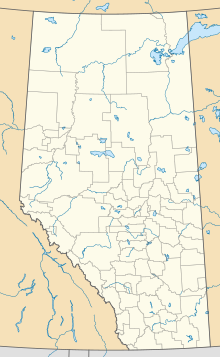Blue Ridge, Alberta
Blue Ridge | |
|---|---|
Location of Blue Ridge in Alberta | |
| Coordinates: 54°07′30″N 115°22′40″W / 54.1250°N 115.3778°W | |
| Country | Canada |
| Province | Alberta |
| Census division | No. 13 |
| Municipal district | Woodlands County |
| Government | |
| • Type | Unincorporated |
| • Governing body | Woodlands County Council |
| Area (2021)[1] | |
| • Land | 2.98 km2 (1.15 sq mi) |
| Population (2021)[1] | |
| • Total | 211 |
| • Density | 70.8/km2 (183/sq mi) |
| Time zone | UTC−7 (MST) |
| • Summer (DST) | UTC−6 (MDT) |
Blue Ridge is a hamlet in northwest Alberta, Canada within Woodlands County.[2] It is located on Highway 658, 7 kilometres (4.3 mi) north of Highway 43 and 3 kilometres (1.9 mi) south of the Athabasca River. It is midway between the towns of Whitecourt and Mayerthorpe and approximately 159 kilometres (99 mi) northwest of Edmonton.
Economy
[edit]A lumber mill to the north of Blue Ridge, operated by Blue Ridge Lumber Inc., is the main employer for the community. The hamlet also offers services to the oil and gas industry and the surrounding agricultural community.
Demographics
[edit]| Year | Pop. | ±% |
|---|---|---|
| 1941 | 76 | — |
| 1951 | 145 | +90.8% |
| 1956 | 195 | +34.5% |
| 1961 | 233 | +19.5% |
| 1966 | 187 | −19.7% |
| 1971 | 239 | +27.8% |
| 1976 | 195 | −18.4% |
| 1981 | 165 | −15.4% |
| 1986 | 163 | −1.2% |
| 1991 | 232 | +42.3% |
| 1996 | 274 | +18.1% |
| 2001 | 230 | −16.1% |
| 2006 | 208 | −9.6% |
| 2011 | 239 | +14.9% |
| 2016 | 244 | +2.1% |
| 2021 | 211 | −13.5% |
| Source: Statistics Canada [3][4][5][6][7][8][9][10][11][12][13][14][15][16][1] | ||
In the 2021 Census of Population conducted by Statistics Canada, Blue Ridge had a population of 211 living in 89 of its 97 total private dwellings, a change of -13.5% from its 2016 population of 244. With a land area of 2.98 km2 (1.15 sq mi), it had a population density of 70.8/km2 (183.4/sq mi) in 2021.[1]
As a designated place in the 2016 Census of Population conducted by Statistics Canada, Blue Ridge had a population of 244 living in 101 of its 105 total private dwellings, a change of 2.1% from its 2011 population of 239. With a land area of 2.98 km2 (1.15 sq mi), it had a population density of 81.9/km2 (212.1/sq mi) in 2016.[16]
See also
[edit]References
[edit]- ^ a b c d "Population and dwelling counts: Canada and designated places". Statistics Canada. February 9, 2022. Retrieved February 10, 2022.
- ^ "Specialized and Rural Municipalities and Their Communities" (PDF). Alberta Municipal Affairs. June 3, 2024. Retrieved June 14, 2024.
- ^ Ninth Census of Canada, 1951 (PDF). Vol. SP-7 (Population: Unincorporated villages and hamlets). Dominion Bureau of Statistics. March 31, 1954. Retrieved September 19, 2024.
- ^ Census of Canada, 1956 (PDF). Vol. Population of unincorporated villages and settlements. Dominion Bureau of Statistics. October 25, 1957. Retrieved September 19, 2024.
- ^ 1961 Census of Canada: Population (PDF). Series SP: Unincorporated Villages. Vol. Bulletin SP—4. Ottawa: Dominion Bureau of Statistics. April 18, 1963. Retrieved September 19, 2024.
- ^ Census of Canada 1966: Population (PDF). Special Bulletin: Unincorporated Places. Vol. Bulletin S–3. Ottawa: Dominion Bureau of Statistics. August 1968. Retrieved September 19, 2024.
- ^ 1971 Census of Canada: Population (PDF). Special Bulletin: Unincorporated Settlements. Vol. Bulletin SP—1. Ottawa: Statistics Canada. March 1973. Retrieved September 19, 2024.
- ^ "Geographical Identification and Population for Unincorporated Places of 25 persons and over, 1971 and 1976". 1976 Census of Canada (PDF). Supplementary Bulletins: Geographic and Demographic (Population of Unincorporated Places—Canada). Vol. Bulletin 8SG.1. Ottawa: Statistics Canada. May 1978. Retrieved September 19, 2024.
- ^ 1981 Census of Canada (PDF). Place name reference list. Vol. Western provinces and the Territories. Ottawa: Statistics Canada. May 1983. Retrieved September 19, 2024.
- ^ 1986 Census of Canada (PDF). Population. Vol. Unincorporated Places. Ottawa: Statistics Canada. July 1988. Retrieved September 19, 2024.
- ^ 91 Census (PDF). Population and Dwelling Counts. Vol. Unincorporated Places. Ottawa: Statistics Canada. June 1993. Retrieved September 19, 2024.
- ^ 96 Census (PDF). A National Overivew: Population and Dwelling Counts. Ottawa: Statistics Canada. April 1997. Retrieved September 19, 2024.
- ^ "Population and Dwelling Counts, for Canada, Provinces and Territories, and Census Divisions, 2001 and 1996 Censuses - 100% Data (Alberta)". Statistics Canada. August 15, 2012. Retrieved September 19, 2024.
- ^ "Population and dwelling counts, for Canada, provinces and territories, and designated places, 2006 and 2001 censuses - 100% data (Alberta)". Statistics Canada. July 20, 2021. Retrieved September 19, 2024.
- ^ "Population and dwelling counts, for Canada, provinces and territories, and designated places, 2011 and 2006 censuses (Alberta)". Statistics Canada. February 8, 2012. Retrieved September 19, 2024.
- ^ a b "Population and dwelling counts, for Canada, provinces and territories, and designated places, 2016 and 2011 censuses – 100% data (Alberta)". Statistics Canada. February 8, 2017. Retrieved February 13, 2017.
54°07′30″N 115°22′40″W / 54.12500°N 115.37778°W

